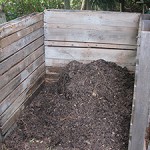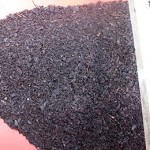Composting 101
- "Pallet Compost Bin"
- "Compost Sifter"
- "Fluffy Sifted Compost"
I was explaining to her that the bacterial action heated the compost pile. “Does it smell?” she asked me.
I was sitting next to a very smart college graphics student the other night. I showed her my new design for my business card hoping to get some critical help. “So you sell compost?” she asked me. I told her that I make it, and can sell it. She asked me if it was difficult to make, and wondered what composter she should buy and what she should put in it. I realized that many of the articles in this blog so far miss the questions for which someone like her really needs answers, and the people that I most hope to reach are the very people who would ask her questions. Meanwhile I am studying the science of this which thrills me and other veteran composters perhaps, and writing articles that would scare a beginner right out of composting. Sure there’s science to it and the science helps us to have a deeper understanding, but compost happens no matter what the depth of our understanding. It is a natural process and happens on the forest floor, in your lawn when you mow and leave the cuttings on the ground, or wherever plant material falls to the ground and lays there decaying. Most of us create compost with only a little reading up ahead. If you are considering composting for the first time, and don’t have a clue what to do first start here, and thank you so much Stacy for waking me up. This article is for you doll.
Composters
You can for sure buy a composter, but the size of your investment does not guarantee better compost. If you don’t mind turning your compost now and then (and I recommend you do) you can get away with a little or no investment. My choice home composter design is three shipping pallets lashed together with long zip ties, and a fourth pallet that slides across the opening to keep creatures out. Try to get at least 3 pallets with very small spaces between the boards. I got my pallets from my local feed store. They gave me ones that were too beat to use for shipping again. They were perfect for my composters. If you don’t like the idea of zip ties you can run a 1×3 board from corner to corner on two corners and put a couple of screws or nails in it, or 2 right angle brackets on each of two corners. I have also seen animal cage composters. You may have a large enough animal cage that you can load your compost into. You will have to take the animal out first though. The mesh on the wire needs to be relatively small to keep the compost in, and the cage needs to have space for a pile at least 3’x3’x3′. You can make a plywood composter, or use fence sections, or even use bales of hay for the walls of a compost pile. Eventually the hay breaks down too, but that is just a bonus. If you can find a 55 gallon drum with a lid you can drill air holes into the drum, and roll it around periodically to aerate and mix the compost. You should find out what was in the drum before. If it held something poisonous you don’t want it for your compost. If you just gotta throw your money at this there are some great drum composters you can find on frames and wheels, and you can crank the barrel over on the wheels to mix the compost. I would recommend getting the largest one available. Compost doesn’t work well unless it has some volume to it. Here is a link for composters;
What To Compost
You can compost all of your kitchen wastes except meat products, and greasy stuff. That stuff will break down but it will stink up your compost, and will attract pests like raccoons and dogs and lions. Vegetable waste and peelings, egg shells, coffee grinds and filters, tea and tea bags are all great compost additives. Mostly they contribute to the nitrogen or green side of your compost pile’s needs. Grass clippings, and green plant clippings, weeds and manure are all green or nitrogen contributors to your compost. Grass clippings should be well shredded, and dried in the sun for a day or so to help avoid clumping up and blocking oxygen from the pile. Manure is great for your compost, but only manure from herbivores should be used. Manures from carnivores and omnivores are more likely to have pathogens that we might like to avoid. Manures from cattle, horses and ponies, rabbits, llamas and alpacas are generally good. Be aware that if you are using manure from creatures that have just been wormed the worms in your compost will be killed by the residual poison in the manure. That is an unfortunate step backwards for a compost pile with a well established worm population. Worms are great grinders of organic material, and their castings or manure, rich in calcium, bacteria, enzymes and micro-nutrients. makes the finest soil available for plants.
Your compost also needs carbon items, or brown items. Carbon items are dry leaves, straw, sticks and twigs, wood shavings, saw dust, pet fur, and newspaper. If you would like your finished compost any time soon make sure all of that stuff is shredded or ground up. When I collect leaves I run them through the lawnmower before I throw them in my compost pile. Straw is a great compost item, it tends to create space for air throughout the compost pile. Sticks and twigs are great for aeration too, but will take a long time to break down. You can speed that a little by breaking or grinding sticks so that they are in pieces no longer than an inch. Newspaper is good if shredded, otherwise it mats up pretty badly, blocks oxygen and slows the compost. Wood shavings like what’s used for pet bedding is fine. Wood chips are generally too big to break down quickly. Saw dust is fine if used sparingly. If you put too much saw dust it will clump up and block air from the pile.
Air and Water
Compost happens. It will happen no matter what. Composting the way nature would do it is called passive composting. Throw everything in a pile and walk away. That’s passive. I do that, it is perfect for the big stuff you just want to keep out of the landfill. I build those piles in strategic locations on my property for convenience. When I am doing some heavy duty pruning and cleaning those piles shoot to the sky. They burn themselves down pretty fast, but on their own schedule. Don’t count on harvesting that anytime soon. If you have a specific need for your compost and you would like it as quickly as possible create a balance. Make sure everything in the pile is relatively small. Be sure the pile is well aerated by turning it now and again, and make sure the compost is wet enough but not soggy. Ideal moisture for your compost is about 50%. The composting process tends to cook and dry so that you may have to water now and then if it is not raining regularly, and for sure water when you are adding material to the pile. If it is raining a whole lot you may need to turn your pile more frequently to help aerate and dry it some.
Does It Smell?
When I told my friend the compost pile had bacteria working in it to make heat she asked me if it smelled. The bacteria that belongs in the compost pile keeps it from smelling bad. It should smell like earth, or soil. A bad smell indicates an anaerobic condition. It can smell if it is too wet, or if there is too much kitchen garbage and not enough brown material to balance it out. Or if you just toss your kitchen wastes on the top. Better to fold them into the middle. I don’t know anyone who keeps the compost bin under a window or close to the back door, but mostly the pile won’t smell bad. If it does, figure out what is making the smell, and turn the pile, or add some brown stuff. Matted grass clippings can get smelly. Break that stuff up, flip the pile, and turn it under again.
Don’t Worry
Worry about your vegetable garden, don’t worry about your compost. You will develop an intuition about how your compost is working the longer you are around it. I think that is why I like having open compost bins, and a garden fork to turn it. I like seeing what is going on. My first compost piles had some problems, but these are life’s simple problems and each time you solve one you become a better compost keeper. So I say, don’t worry about compost. It will happen. There are no consequences that you can not handle in this classroom. 😀
How To Use Your Compost
If you intend to add your finished compost to your vegetable garden or potting mix you may want to sift it over a wire frame to leave out the big pieces that are not quite broken down. I nailed some half inch hardware cloth onto a 2×2 wooden frame that is just a bit bigger than my wheel barrow, and I sift my compost through there and into my wheel barrow. What’s left on the top of the screen gets thrown back to the compost pile. If you are going to use your compost around plants as a top dressing you don’t have to sift it first. The big pieces will act as mulch and will continue to break down and feed your plants as they do.
Need To Know More?
If you enjoyed this article, and are ready for more information on composting check out the following articles at this site: Leaves: Black Gold , The Compost Pile , Invertebrates Of The Compost Pile , Microbial Life Of A Compost Pile ,
Happy Composting



